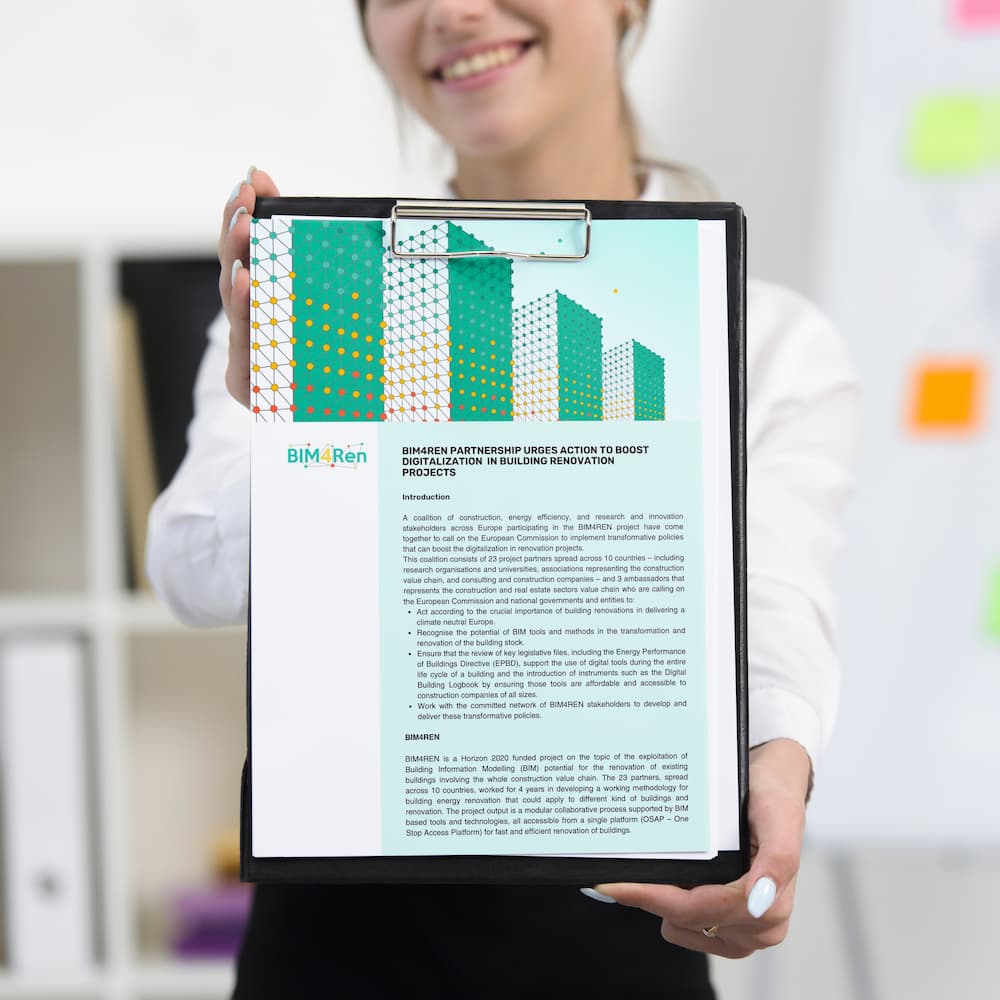Get engaged
Innovation by Design
All the actors of the construction value chain have to be made aware of these opportunities and convinced to do their part because, for complex problems, systemic solutions and integrated approaches always represent the best way forward.
The advocacy activity aims at bringing messages and testimonials to push stakeholders to act now and all together in innovating the construction processes to increase the building renovation rates in members states and Europe.
The White Paper
It is a useful resource to find case studies and practical guidance for understanding how digitalization is strategic to support meeting the objectives of the renovation policies in Europe.
It is a motivational guide for construction stakeholders and particularly SMEs that need the digital transition lever to innovate their usual practice and make the shift toward a collaborative approach in a common open BIM environment.
The White Paper collects the BIM4REN project’s lesson learnt and a set of recommendations for enhancing the role of BIM in delivering the Renovation Wave that is the challenge of the building sector of today.
Lessons learnt
Lesson 1
Digital Building Logbook
Lesson 2
BIM & design phases
Lesson 3
From BIM to BEM
Lesson 4
Relative versus absolute
Discover BIM4Ren's Ambassador
BIM4Ren project aims to raise the awareness of institutions and stakeholders on the need to accelerate the digital transition in the building construction and management processes.
The ultimate goals are the promotion of a systemic approach to the project with the involvement of all stakeholders, and the accelerations of the rate of energy efficient renovations in Europe and in the member states.typesetting, remaining essentially unchanged.
Some prominent figures dealing with BIM and digitalization in the building sector were involved in the advocacy campaign as ambassadors.
Read Ambassadors’ quotes supporting the BIM4Ren vision and enjoy their interviews
#BIM4RENAMBASSADOR
ANNA MORENO
President- IBIMI buildingSMART Italy


#BIM4RENAMBASSADOR
“The ambition for sustainable construction and renovation projects benefits from the combination of digital methods based on BIM, Model & Code Checking and Life Cycle Assessment, as a prerequisite for dynamic realtime monitoring of asset performances. Internet of Things, Digital Twin and Artificial Intelligence will guarantee the sustainability goals to be achieved over time.”
PAOLO ODORIZZI
Head of Research & Innovation HARPACEAS


#BIM4RENAMBASSADOR
“The ecological transition and the development of a green society are challenges where the construction sector plays a fundamental role.
BIM methodology is a key element for the integration of sustainability requirements in projects and can be a model for the optimization of processes and achievement of the environmental and energy goals.”
ADRIANO CASTAGNONE
President - ASSOBIM


Our open letter to European and National Institutions
The letter contains a high-level message addressed to the European Commission and the national governments and entities involved in buildings renovation policies.
All BIM4Ren partners provided their endorsement, and the message will be spread in conferences and events in various countries to raise awareness on the digitalization in the buildings’ renovation process.
We are ready and willing to work with the European and National Institutions and invite you to join the conversation #bim4renovation.
“There is no longer any doubt today that the evolution of the European construction sector will take place through a joint transition towards greater digitalisation, provided that it embraces the entire construction value chain, coupled with improved environmental performance. To achieve this, it is essential that digital innovation is driven by the real needs of the main players in the European construction industry, its micro, small and medium-sized builders, but also by the reality of the market, namely the vital need to improve the energy performance of buildings, especially residential buildings.”
Fernando Sigchos Jiménez
EBC Secretary General




